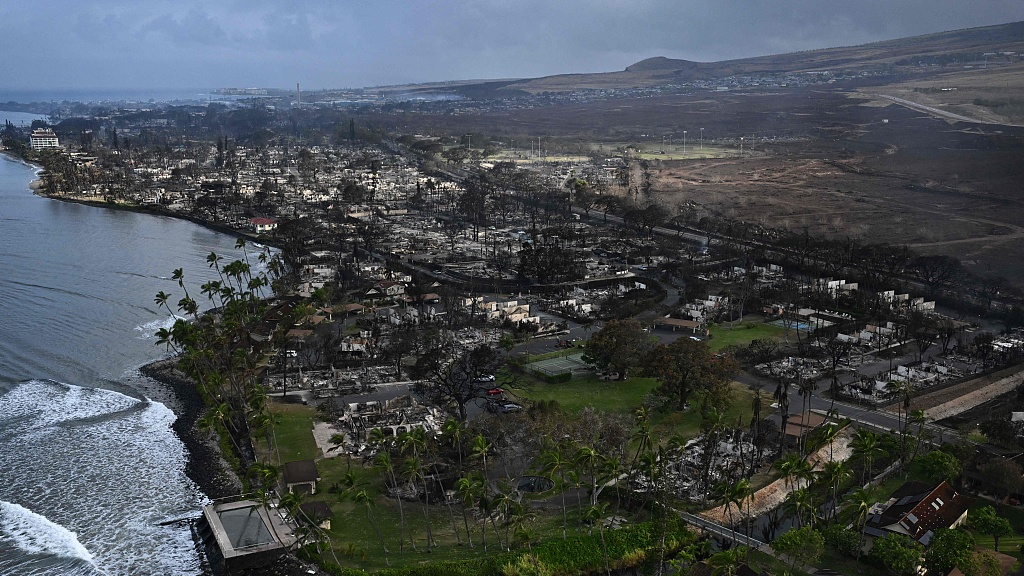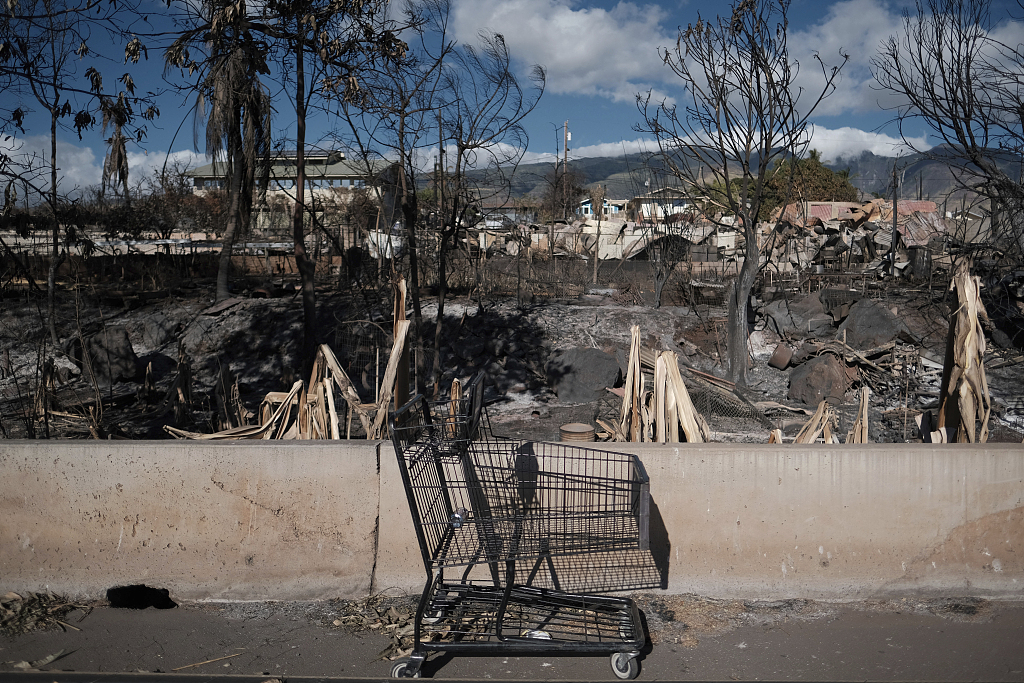
An aerial view of Lahaina after wildfires burned through the town on the island of Maui in Hawaii, the U.S., August 10, 2023. /VCG
An aerial view of Lahaina after wildfires burned through the town on the island of Maui in Hawaii, the U.S., August 10, 2023. /VCG
Editor's note: Yi Xin is a Beijing-based observer. The article reflects the author's opinions and not necessarily the views of CGTN.
The historic town of Lahaina, once a popular tourist resort in Maui County, Hawaii, is wiped off the map. A raging wildfire, the deadliest in the U.S. in a century and the worst natural disaster in Hawaii state history has killed 115 and destroyed 2,700 structures in the town, leaving 385 unaccounted for and tens of thousands displaced as of the end of August.
While the inferno is of nature's making in the first place, questions abound about the emergency preparedness and response of the most powerful country in the world.
Caught unprepared
Creaky power grid, understaffed fire brigades, dried-up water hydrants, silent sirens – the disaster has laid bare a dilapidated infrastructure and an underfunded public sector.
According to a CNN report, the Maui County authorities have long been warned of fire risks and advised to take mitigating measures including removing combustible, intrusive plants. The warning, however, went unattended due to a lack of money and manpower, among others.
What Maui experienced is only a microcosm of the nationwide challenge of chronic underfunding for forest management. Between 1995 and 2015, the U.S. Forest Service saw its annual fire suppression costs soaring from 16 percent to more than 50 percent of its overall budget, sapping up funding for fire prevention programs. As former Agriculture Secretary Tom Vilsack puts it, the agency is basically "paying for today's fires by stealing from programs that reduce the threat of future catastrophic fires."
The vicious cycle of underfunding, unpreparedness and higher risks and costs has taken hold.

A shopping cart is left near a residential area in the wildfire-ravaged town of Lahaina on the island of Maui in Hawaii, the U.S., August 19, 2023. /VCG
A shopping cart is left near a residential area in the wildfire-ravaged town of Lahaina on the island of Maui in Hawaii, the U.S., August 19, 2023. /VCG
American people last?
While forestalling a natural disaster may be too much to ask of any government, the government response to the Hawaii fires is certainly not up to the mark. Survivors of the blaze are left out in the cold, with sweeping government relief efforts largely missing during the first 72 hours. Residents had to set up their own distribution network and rely on word of mouth to get access to critical supplies like drinking water and fuel.
Ring a bell here? The government came under fire for a similarly inept response to Hurricane Katrina. But that was almost 20 years ago. The lesson, alas, has not been learned.
While the Joe Biden administration announced an aid of $700 to each affected household in Maui, it concurrently pledged $200 million in new security assistance to Ukraine. Naturally, the glaring disparity has caused a public outcry. A video juxtaposing Ukrainian holidaymakers on the beach with Maui residents jumping into the Pacific to escape the flames went viral on social media. Many Americans are enraged that their government could generously squander resources in a war far across the sea and yet is unwilling and unable to direct resources to its own people on its own soil.
This could not be further away from the government "of the people, by the people, for the people" that America's founding fathers envisioned. Or maybe the Hawaii fires are not a big deal to the government after all. When touring the damage in Maui, President Biden talked about the blaze in the same breath as a kitchen fire at his Delaware home in 2004.
Difficult rebuild ahead
For residents in Lahaina, the road to rebuild is set to be long and difficult.
According to Hawaii Governor Josh Green, Lahaina will have to be "completely rebuilt," a process that will "take years" at a cost of more than $5 billion. With construction costs soaring in disaster-stricken areas, federal aid is woefully inadequate to cover the home repair bills of each household. Locals who have lost their homes and livelihoods will have to struggle to get their lives back on track.
Yet limited government assistance might not be the only hindrance to reconstruction. Discrimination and social injustice are also cause for concern. According to an NPR report, the Federal Emergency Management Agency follows a fund distribution approach that in effect favors the rich over the poor and discriminates against historically underprivileged communities. As a result, many less wealthy neighborhoods are never able to fully recover following a disaster.
A case in point is the Lower Ninth Ward District in New Orleans. In 2015, when more than half of New Orleans' neighborhoods had recovered 90 percent of their population before Katrina, the district remained desolate and only about one-third of its predominantly African-American residents returned. That is indeed a tale of two cities.
Will Lahaina fare any differently? That could be anybody's guess.
(If you want to contribute and have specific expertise, please contact us at opinions@cgtn.com. Follow @thouse_opinions on Twitter to discover the latest commentaries in the CGTN Opinion Section.)